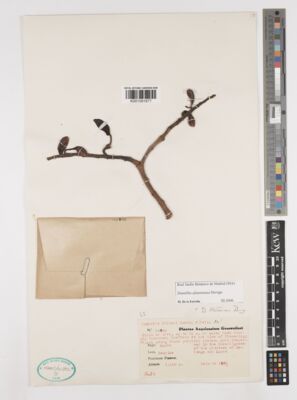Geography and distribution
Daniellia alsteeniana is distributed in a band across the drier southern portion of the Congo basin. It has been recorded from Gabon (one record), through the western and southern Democratic Republic of Congo and northeastern Angola, and into northeastern Zambia. It is a linking species of the Guineo-Congolian and Zambesian centres of plant endemism (places containing plants that are restricted to a particular area). In parts of its range, it grows on nutrient-poor, freely draining, ancient, wind-borne sand deposits known as the 'Kalahari sands'.
Description
Daniellia alsteeniana is a medium-sized or large tree, often up to 10-20 m tall with a dense crown of dark green and glossy foliage beneath a leafless mass of flowers or fruits. The trunk is up to 1 m in diameter. Leaves are compound (divided into leaflets) with 4-7 pairs of leaflets, each leaflet being elliptic or oblong in shape and typically about 10 cm long and 5 cm wide with a sharply pointed tip and largely hairless surfaces.
Large, branched, spreading inflorescences (flowering parts) are held above the crown and together form pink, flowering masses. Inflorescence branches are woody and tough. Each flower is held upright on a stiff stalk 2-3 cm long that ends in a swollen, deep-pink flower base (hypanthium). The four sepals are thick and waxy and overlap, two on the outside, two within. They are pink at the base outside and creamy towards the tip and within, and are about 2 cm in diameter. There are two large, rounded, pink lateral petals about 16-18 mm long with inrolled (rolled inwards) margins, a smaller, narrower, green lower petal with a strongly inrolled reddish margin, and two minute upper petals, which are largely hidden.
Ten stamens (male organs) are grouped into a bundle up to 5 cm long, extending well beyond the petals and sepals; the white waxy filaments (stamen stalks) curve downwards towards the white anthers (pollen-bearing parts). The ovary is green, whereas the style (female receptive area on the end of the ovary) is white and curved. The fruit is a single-seeded, flattened pod up to 10 cm long. The seed is shiny and brown and held on a long stalk (funicle).
Pollination within the genus
The genus Daniellia comprises ten tree species restricted to tropical and subtropical Africa, with most species recorded from the wet forests of West Africa and the Congo River basin. Daniellia alsteeniana is one of only two species found in drier forest and savanna (wooded grassland), the other being D. oliveri, which occurs further north in the broad 'Sahel' region.
Pollinators of Daniellia species have not been well documented, but the second dry-country species, D. oliveri , is known to be pollinated by bats and it is thought that this may also be the case for D. alsteeniana . Observations made by Kew botanists of flowering trees around their campsite in Angola indicated that D. alsteeniana is frequently visited by sunbirds and other nectar-loving bird species, which probably also act as pollinators.
Threats and conservation
Daniellia alsteeniana is widespread in southern Congo where it is, however, said to be exploited for timber and also used as a source of gum resin. Kew botanists saw no evidence of exploitation in northeastern Angola, where vast areas of sparsely inhabited woodlands and dry forests appear to be a stronghold for D. alsteeniana . It is rare in both Gabon and Zambia.
The rapid biodiversity survey of the Lagoa Carumbo region of northeastern Zambia, in which Kew led the botanical aspects, was part of the Angolan Protected Areas Expansion Strategy programme, in which potential priority sites for conservation are being investigated across the country. The evidence compiled from Kew's April-May 2011 trip to Angola demonstrated that the Carumbo region contains rich and varied plant and animal life, with a number of localised and unique species. This area is now being considered for designation by the authorities as a large, new national park, which should help to safeguard the future of D. alsteeniana in Angola.
Uses
As with a number of Daniellia species, D. alsteeniana is a source of both timber and gum resin. The more widely used West African species are well documented in Burkill's 'The Useful Plants of West Tropical Africa'. Daniellia alsteeniana is described as producing a 'magnificent clear copal' (gum) but the quantities are insufficient for commercial exploitation. Gum of the related D. oliveri is used widely as a varnish. At Lagoa Carumbo in Angola, Kew botanists were told that local villagers use D. alsteeniana for making dugout boats.
This species at Kew
Pressed and dried specimens of Daniellia alsteeniana , including a collection from the April-May 2011 expedition to Angola, are held in Kew's Herbarium where they are available to researchers by appointment.
Assessing plant conservation priorities in Angola
Kew is participating in a multi-national, multi-disciplinary project that aims to identify priority sites to expand the protected areas network in Angola. Kew is leading the botanical aspects of this work in collaboration with partners in Angola. The expedition to the Lagoa Carumbo region of Lunda Norte, northeastern Angola was the first in a series of biodiversity assessments to provide data to support this programme.
The flora of Angola is rich, with a wide variety of habitats and several regions of high species diversity and high numbers of endemic species (those found only in Angola). However, it also remains one of the least well botanically studied countries in Africa. There is therefore a great need to carry out plant survey work and vegetation studies throughout this exciting country.



